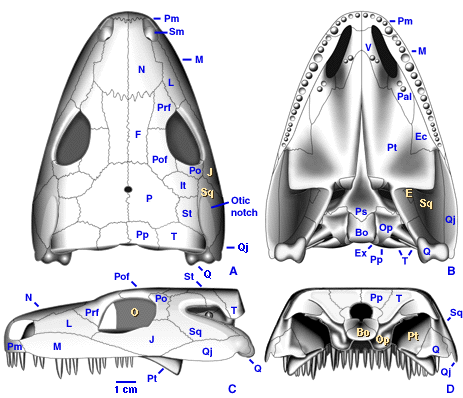Seymouria
Michel Laurin
- Seymouria sanjuanensis

- Seymouria baylorensis

- Seymouria grandis

Introduction
Seymouria is by far the best known seymouriamorph (White, 1939; Berman et al., 1987; Laurin 1995, 1996a). It is represented by several well ossified postmetamorphic specimens with excellent three-dimensional preservation. However, its larvae are not known. Seymouria has long been known from strata in North America, and two specimens were recently found in Germany (Berman and Martens, 1993). These specimens are also the smallest and presumably ontogenetically youngest known specimens of Seymouria.
Seymouria includes three valid species that lived in the Lower Permian. S. baylorensis is represented by the largest number of specimens, all of which were found in Texas (White, 1939). S. sanjuanensis includes the smallest known specimens of Seymouria and some relatively large specimens (Vaughn, 1966). It was fairly widespread and has been found in Utah, New Mexico, and Germany (Berman et al., 1987). S. grandis is represented by fragmentary remains found in Oklahoma and Texas (Olson, 1979).
Characteristics
Seymouria, like Kotlassia, is known from several three-dimensional skeletons of mature individuals. Because of this, its skull can be reconstructed with much more confidence than most other seymouriamorphs. Its postcranial anatomy is also well known because its limb bones were well ossified, whereas those of many other seymouriamorphs still had cartilaginous ends.
Several of the autapomorphies of seymouriamorphs were first noticed in Seymouria, and some potential autapomorphies of seymouriamorphs are still only documented in this genus. These include:
- A small posttemporal fenestra (a hole in the occiput through which blood vessels and nerves entered or exited the skull).
- A closed palate without an interpterygoid vacuity.
- In most tetrapods and their relatives, a long median slit called the interpterygoid vacuity separates the two pterygoids (the largest bones of the palate). Other seymouriamorphs were previously believed to have had an interpterygoid vacuity, but recent studies suggest that Ariekanerpeton and Discosauriscus had a closed palate, like Seymouria (Laurin, in press; Klembara, personal communication).
- A slender stapes that probably transmitted sounds from the tympanum to the inner ear.
- A tympanic middle ear was probably present in all seymouriamorphs, but the stapes is best preserved in Seymouria.
- Sharp notches in the anteroventral and posteroventral corners of the orbit.
- These notches have not been observed in other seymouriamorphs yet. They may be genuine autapomorphies of Seymouria.
- A long, ventrally bent process of the tabular.
- This character may be partly ontogenetic. Small specimens of seymouriamorphs like most known specimens of Utegenia lacked the process. The smallest known specimens of Seymouria had a small process that was only slightly bent ventrally, and the larger specimens had a long, ventrally bent process.
Seymouria also had a transverse flange of the pterygoid that extended ventrolaterally, as in early amniotes. Earlier workers believed that the flange was horizontal because it is compressed in the horizontal plane in most specimens of other seymouriamorphs (White, 1939).
The neural arches were swollen (strongly convex dorsally, in anterior or posterior view). All seymouriamorphs had swollen neural arches, but this feature is most obvious in large specimens of Seymouria. The neural arches of all known specimens of Seymouria were solidly fused to their centra, and no sutures are visible.
The humerus and femur were robust. Their proximal and distal heads were strongly expanded to accommodate the limb musculature. The relatively short forelimb and shank suggest that Seymouria was not a particularly fast animal.
No scales have been found, but this could be an artifact of preservation.
References
Berman, D. S., R. R. Reisz, & D. A. Eberth. 1987. Seymouria sanjuanensis (Amphibia, Batrachosauria) from the Lower Permian Cutler Formation of north-central New Mexico and the occurrence of sexual dimorphism in that genus questioned. Canadian Journal of Earth Sciences 24: 1769-1784.
Berman, D. S. &;T. Martens. 1993. First occurrence of Seymouria (Amphibia: Batrachosauria) in the Lower Permian Rotliegend of central Germany. Annals of Carnegie Museum 62: 63-79.
Laurin M. 1995. Comparative cranial anatomy of Seymouria sanjuanensis (Tetrapoda: Batrachosauria) from the Lower Permian of Utah and New Mexico. PaleoBios 16: 1-8.
Laurin M. 1996a. A redescription of the cranial anatomy of Seymouria baylorensis, the best known seymouriamorph (Vertebrata: Seymouriamorpha). PaleoBios 17: 1-16.
Laurin, M. 1996b. A reevaluation of Ariekanerpeton, a Lower Permian seymouriamorph (Tetrapods: Batrachosauria) from Tadzhikistan. Journal of Vertebrate Paleontology 16 (4): 653-665.
Olson, E. C. 1979. Seymouria grandis n. sp. (Batrachosauria: Amphibia) from the Middle Clear Fork (Permian) of Oklahoma and Texas. Journal of Paleontology 53: 720-728.
Vaughn, P. P. 1966. Seymouria from the Lower Permian of Southeastern Utah, and possible sexual dimorphism in that genus. Journal of Paleontology 40: 603-612.
White, T. E. 1939. Osteology of Seymouria baylorensis Broili. Bulletin of the Museum of Comparative Zoology 85: 325-409.
Title Illustrations
| Scientific Name | Seymouria baylorensis |
|---|---|
| Location | Texas |
| Comments | Cranial reconstruction in dorsal (A), palatal (B), left lateral (C), and occipital (D) views. S. baylorensis is represented by several specimens from Texas. |
| Reference | Modified from Laurin M. 1996. A redescription of the cranial anatomy of Seymouria baylorensis, the best known seymouriamorph (Vertebrata: Seymouriamorpha). PaleoBios 17:1-16. |
| View | dorsal, palatal, left palatal, occipital |
| Copyright | © 1996 Michel Laurin |
About This Page
I thank my wife (Ms. Patricia Lai) and Mr. Matthew Marlowe for editing this page. Dr. David Maddison provided invaluable assistance in formatting this page and in linking it to other pages of the Tree of Life.
Michel Laurin
URA CNRS 1137
"Evolution et adaptations des syst?mes ost?omusculaires"
Case 7077
Universit? Paris 7
Paris 75005
France.
Correspondence regarding this page should be directed to Michel Laurin at
Page copyright © 1996 Michel Laurin
Citing this page:
Laurin, Michel. 1996. Seymouria. Version 01 January 1996 (tol-reviewed). http://tolweb.org/Seymouria/17546/1996.01.01 in The Tree of Life Web Project, http://tolweb.org/









